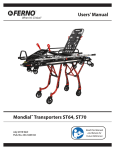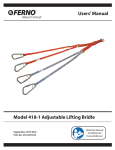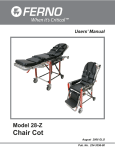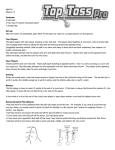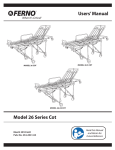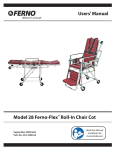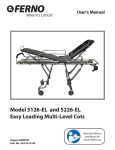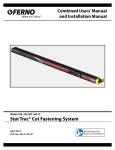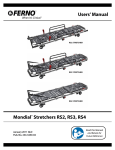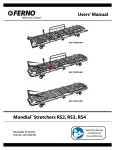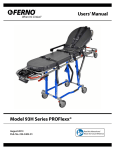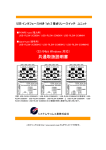Download User Manual Mondial Monobloc english
Transcript
FERNO ® When It’s Critical ® Users’ Manual Mondial® Monobloc January 2012 GLO Pub. No. 234-3480-01 Read this Manual and Retain for Future Reference Mondial® Monobloc Ferno Technical Support Ferno Technical Support Customer service and product support are important aspects of each Ferno product. Please have the product serial number available when calling, and include it in all written communications. For technical support questions: Text Message [email protected] [email protected] Telephone (Toll-free) 1.800.733.3766 ext. 1010 Telephone 1.937.382.1451 ext. 1010 Ferno Customer Relations For ordering assistance or general information: Canada and the U.S.A. Telephone (Toll-free) 1.877.733.0911 Telephone 1.937.382.1451 Fax (Toll-free) 1.888.388.1349 Fax1.937.382.1191 Internetwww.ferno.com All Other Locations For assistance or information, please contact your Ferno distributor. If you do not have a Ferno distributor, please contact Ferno Customer Relations: Ferno-Washington, Inc. 70 Weil Way Wilmington, Ohio 45177-9371, U.S.A. Telephone +1.937.382.1451 Fax+1.937.382.6569 Internetwww.ferno.com European Representative Ferno (UK) Limited Stubs Beck Lane, Cleckheaton West Yorkshire BD19 4TZ, United Kingdom Telephone +44 (0) 1274 851999 Fax +44 (0) 1274 851111 Internetwww.ferno.co.uk users’ manual To request additional free users’ manuals, contact Ferno Customer Relations, your Ferno distributor, or visit www.ferno.com. Serial Number _________________________ Location: Patient-left side rail under the backrest Disclaimer This manual contains general instructions for the use, operation, and care of this product. The instructions are not all-inclusive. Safe and proper use of this product is solely at the discretion of the user. Safety information is included as a service to the user. All other safety measures taken by the user should be within and under consideration of applicable regulations. It is recommended that training on the proper use of this product be provided before using this product in an actual situation. Retain this manual for future reference. Include it with the product in the event of transfer to new users. Additional free copies are available upon request from Customer Relations. Proprietary Notice The information disclosed in this manual is the property of Ferno-Washington, Inc., Wilmington, Ohio, USA. FernoWashington, Inc. reserves all patent rights, proprietary design rights, manufacturing rights, reproduction use rights, and sales use rights thereto, and to any article disclosed therein except to the extent those rights are expressly granted to others or where not applicable to vendor proprietary parts. Limited Warranty Statement The products sold by Ferno are covered by a limited warranty, which is printed on all Ferno invoices. The complete terms and conditions of the limited warranty, and the limitations of liability and disclaimers, are also available upon request by calling Ferno at 1.800.733.3766 or 1.937.382.1451. © Copyright Ferno-Washington, Inc. All Rights Reserved. 2 © Ferno-Washington, Inc 234-3480-01 January 2012 Table of Contents Mondial® Monobloc Table of Contents SectionPage SectionPage Ferno Customer Relations_______________________ 2 Ferno Technical Support________________________ 2 1 - Safety Information____________________________ 4 1.1Warning_________________________________ 4 1.2Important________________________________ 4 1.3 Bloodborne Disease Notice__________________ 4 1.4 Cot and Fastener Compatibility______________ 4 1.5 Safety and Instruction Labels________________ 5 1.6 Symbol Glossary__________________________ 5 2 - Operator Skills and Training___________________ 6 2.1Skills___________________________________ 6 2.2Training_________________________________ 6 2.3 Height and Strength Considerations___________ 6 3 - About the Cot________________________________ 7 3.1Description______________________________ 7 3.2 General Specifications_____________________ 7 3.3Compliance______________________________ 8 3.4 Cot Positions_____________________________ 8 4 - Setup_______________________________________ 9 4.1 Restraints, Mattress and Accessories__________ 9 4.2 Restraint Guidelines_______________________ 9 4.3 Attaching the Leg Restraint________________ 10 4.4 Attaching the Harness ____________________ 11 5 - Using the Features___________________________ 13 5.1 EZ Pull™ Leg Control Handles______________ 13 5.2 Leg-Status Indicator______________________ 13 5.3 Swivel-Lock Release Lever________________ 14 5.4 Wheel Locks____________________________ 15 5.5Sidearms_______________________________ 15 5.6Footrest________________________________ 15 5.7 Shock Frame____________________________ 16 5.8Backrest________________________________ 17 5.9 Backrest with Airway Management Frame (Optional)______________ 17 5.10 Backrest with Extending Headrest (Optional)__ 17 5.11 Intermediate Loading Wheels_______________ 18 5.12Low-Bed Leg Lock (Blue Lever, Optional)____ 18 5.13Telescoping Handles (Optional)_____________ 19 5.14Telescoping Side Handles (Optional)_________ 19 5.15EZ Load™ Automatic Leg Release (Loading-End Legs)______________________ 20 5.16EZ Load™ Automatic Leg Release (Control-End Legs, Optional)_______________ 20 5.17Safety-Lock Device (Optional)______________ 21 5.18 Storage Tray (Optional)___________________ 21 6 - Using the Cot_______________________________ 22 6.1 Before Placing the Cot in Service____________ 22 6.2 General Guidelines for Use_________________ 22 6.3 Changing Cot Positions___________________ 23 6.4 Transferring the Patient____________________ 24 6.5 Rolling the Cot__________________________ 25 6.6 Loading the Cot__________________________ 26 6.7 Unloading the Cot________________________ 27 6.8 Carrying the Cot_________________________ 28 6.9 One Operator, Empty Cot__________________ 28 6.10 Using Additional Help____________________ 29 7 - Maintenance________________________________ 30 7.1 Maintenance Schedule____________________ 30 7.2Tracker™ (Optional)______________________ 30 7.3 Disinfecting and Cleaning the Restraints______ 30 7.4 Disinfecting and Cleaning the Mattress_______ 31 7.5 Disinfecting the Cot ______________________ 31 7.6 Cleaning the Cot_________________________ 31 7.7 Waxing the Cot__________________________ 31 7.8 Inspecting the Cot________________________ 31 7.9 Lubricating the Cot_______________________ 32 8 - Parts and Service____________________________ 33 8.1 U.S.A. and Canada_______________________ 33 8.2Worldwide______________________________ 33 8.3 Parts List_______________________________ 33 9 - Accessories and Related Products______________ 34 Training Record_______________________________ 35 Maintenance Record____________________________ 36 © Ferno-Washington, Inc 234-3480-01 January 2012 3 Safety Information Mondial® Monobloc 1 - Safety Information 1.1Warning 1.2Important Warning notices indicate a potentially hazardous situation which, if not avoided, could result in injury or death. Important notices emphasize important usage or maintenance information. Warning Important Untrained operators can cause injury or be injured. Permit only trained personnel to operate the cot. Improper use of the cot can cause injury. Use the cot only for the purpose described in this manual. Attaching improper items to the cot can cause injury. Use only Ferno-approved items on the cot. 1.3Bloodborne Disease Notice To reduce the risk of exposure to bloodborne diseases such as HIV-1 and hepatitis when using the cot, follow the disinfecting and cleaning instructions in this manual. Releasing the swivel locks increases the possibility for the cot to tip. Maintain control of the cot at all times. Improper operation can cause injury. Operate the cot only as described in this manual. An unattended patient can be injured. Stay with the patient at all times. An unrestrained patient can fall off the cot and be injured. Use restraints to secure the patient on the cot. Rolling the cot sideways can cause the cot to tip and injure the patient or operators. Roll the cot only with the head-end or food-end first. An unlocked undercarriage can cause injury. Before removing the cot from the ambulance, confirm that both sets of legs unfold completely and lock. Helpers can cause injury or be injured. Maintain control of the cot, operate the controls, and direct all helpers. 1.4 Cot and Fastener Compatibility Combining different manufacturers’ products into a “mixedcomponent” cot fastener system can increase the user’s risk of injury and damage. Ferno-Washington, Inc. strongly recommends that only Ferno-manufactured cots be used in Ferno-manufactured cot fasteners, and that only Ferno-manufactured cot fasteners be used for securing Ferno-manufactured cots in ambulances. ANY COMBINATION OF A FERNO COT OR COT FASTENER WITH A NON-FERNO COT OR COT FASTENER IS MISUSE OF THE FERNO PRODUCT. Responsibility for the outcome of known, intentional misuse rests squarely on the misuser. Helpers can be injured. Show helpers where to grasp the stretcher to avoid pinch points. Improper maintenance can cause injury. Maintain the cot only as described in this manual. Modifying the cot can cause injury and damage. Use the cot only as designed by Ferno. Improper parts and service can cause injury. Use only Ferno parts and Ferno-approved service on the cot. Attaching improper items to the cot can cause injury. Use only Ferno-approved items on the cot. 4 © Ferno-Washington, Inc 234-3480-01 January 2012 Mondial® Monobloc Safety Information 1.5Safety and Instruction Labels Safety and instruction labels place important information from the users’ manual on the cot. Read and follow label instructions. Replace worn or damaged labels immediately. New labels are available from EMSAR or your distributor (page 33). Swivel Lock Release Lever (Affixed near blue swivel-lock release lever) Indicates that using the release lever allows the loading-end wheels to swivel 360°. (Use at Bed Position 6). Safety Information Label Low-Bed Leg Lock Lever (Affixed to the control panels) (Affixed near low-bed leg lock lever) (when equipped) Indicates a general injury warning; the cot load limit; reminds that operators need to read the manual and that two trained operators are required. Indicates that engaging the blue lever will lock the legs and allow the cot to be carried like a stretcher. (Use at Bed Position 1). Undercarriage Lock Status (Affixed to undercarriage lock mechanism) Indicates the status of the undercarriage lock: green means the legs are safe/ locked; red means the legs are unlocked for lowering or loading. Pinch Point Labels (Affixed near backrest hinge and beneath shock frame) Indicates potential for injury; keep hands clear of these areas. 1.6Symbol Glossary The symbols defined below are used on the cot and/or in this users’ manual. Ferno uses symbols recognized by the International Standards Organization (ISO), American National Standards Institute (ANSI) and the emergency medical services industry. 2 280 kg 620 lb General Warning of Potential Injury Pinch Point: Keep Hands Clear Read the Users’ Manual Cot Operation Requires Two Trained Operators Load Limit Do Not Lubricate Lubricate Unlocked Locked Product meets European Union Standards © Ferno-Washington, Inc 234-3480-01 January 2012 5 Operator Skills and Training Mondial® Monobloc 2 - Operator Skills and Training 2.1Skills Operators using the cot require: ● a working knowledge of emergency patient-handling procedures. ● the ability to assist the patient. 2.2Training Operator trainees must: ● read and understand this manual and the manual for the cot fastener used with the cot. ● be trained on the use of the cot and the cot fastener used with the cot. ● practice with the cot before using it with a patient. ● record their training information. A sample training record sheet is provided on page 35. Warning Untrained operators can cause injury or be injured. Permit only trained personnel to operate the cot. 2.3Height and Strength Considerations When unloading the cot, the foot-end operator must lift and hold the weight of the cot, patient and equipment high enough for the wheels to remain off the ground until the undercarriage legs completely unfold and lock into position. Be aware that if the ambulance is parked on an uneven surface, the foot-end operator (and any helpers) may need to lift the cot higher than normal to allow the legs to unfold completely and lock. Supporting this weight requires greater strength from short operators than from tall operators, because short operators must raise their arms higher in relation to their shoulders. Note: Use additional help as needed to lift the weight of the cot, patient and equipment (see Using Additional Help, page 29). 6 © Ferno-Washington, Inc 234-3480-01 January 2012 Mondial® Monobloc About the Cot 3 - About the Cot 3.1Description Warning The Ferno® Mondial® Monobloc Series Cot (called the cot in this manual) is an emergency patient-handling device designed to transport a patient in a ground-based ambulance. Improper use of the cot can cause injury. Use the cot only for the purpose described in this manual. The cot is for professional use by a minimum of two trained operators. It is designed for roll-in loading to help reduce the risk of back injury to medical service personnel. Included with purchase In this manual, the generic term, “cot” is used when the feature is shared by all models in the series. The individual cot name is used when features differ. The following items are included with purchase: Cot Features ● Ergonomic control handles ● Choice of red, green, or silver legs ● Six bed positions and a folded position ● Compatible with Ferno® FL1 and EFX-Lock fasteners. ● EZ Pull™ control handles allow operators to operate the control handle first, before assuming the weight of the cot during position changes ● Control handles not required for raising the cot ● Automatic loading-leg release (when loading the cot into an ambulance); control handle not required to unlock loading legs ● Intermediate loading wheels ● Pneumatic backrest ● 3-Position shock frame with contour feature ● 3-Position swing-down sidearms ● Footrest ● Four 150 mm (6 in.) transport wheels ○○ Control-end wheels with wheel locks (two) ○○ Loading-end wheels with swivel locks (two) ● Extremely high-visibility reflective safety stripes ● Scuff strips w/rollers ● Set of restraints optional features ● Automatic operator-leg release (control handle not required to unlock operator-end legs) ● Backrest with extending headrest ● Backrest with airway-management frame ● Low-bed leg lock ● 4 Telescoping carry handles* ● 2 Side-lifting handles* ● Safety-lock device* ● Storage tray* ● Flat or bolster mattress* *(Also available separately) © Ferno-Washington, Inc 234-3480-01 January 2012 ● Set of 2 patient restraints: one harness torso restraint and one two-piece leg restraint ● Users’ manual 3.2General Specifications Most general specifications below are rounded to the nearest whole number. Metric conversions are calculated before rounding the Imperial measurements. For more information, contact Ferno Customer Relations (page 2) or your Ferno distributor. Ferno reserves the right to change specifications without notice. ConstructionAluminum Transport Wheels Diameter 6 in./150 mm Width 2 in./44 mm Wheel Bearings Sealed/greaseless Bed Surface Aluminum panels Height1 Bed Position 6 40 in./1006 mm Loading Height 28 in./700 mm Bed Position 5 37 in./946 mm Bed Position 4 34 in./871 mm Bed Position 3 30 in./752 mm Bed Position 2 23 in./593 mm Bed Position 1 12 in./314 mm Folded (Ambulance) Position 13 in./327 mm Length 77.5 in./1970 mm Width 22 in./553 mm Weight2 98 lb/44.45 kg Load Limit 620 lb/280 kg Note: All Ferno® mattresses for emergency medical service use are heat-sealed. Height measurements are as follows: Loading Position is the distance from the ground to the bottom of the loading wheel. Bed Position is the distance from the ground to the patient surface, measured at the center of the seat panel. 1 Weight is without mattress, restraints and optional features. 2 7 About the Cot Mondial® Monobloc 3.3Compliance 3.4 Cot Positions medical device directive Ferno products meet the requirements of Medical Device Directive 93/42/EEC as established by the European Union. certification The Mondial® Monobloc cot, when used with a Ferno® FL1 or EFX-Lock fastener, meets European Harmonized Standards. Folded (Ambulance) Position U.S.A. Notice The cot is for use with ambulances that meet the requirements of the “Star of Life” certification via Federal Ambulance Specification KKK-A-1822. For information, contact: Federal Supply Services, Specifications Section Suite 8100 470 E. L’Enfant Plaza, SW Washington, DC 20407 Load Limit 280 kg 620 lb Position 1 (Lowest Transfer Position) Inspect the cot if the load limit has been exceeded (See Inspecting the Cot, page 31). Loading Height Bed Height Position 3 (Mid-Level Transfer/Rolling Position) Position 6 (Highest Rolling Position) 8 © Ferno-Washington, Inc 234-3480-01 January 2012 Setup Mondial® Monobloc 4 - Setup 4.1Restraints, Mattress and Accessories Before placing the cot in service, assign appropriate personnel to install the mattress, restraints, and any accessories shipped with the cot. Keep accessory users’ manuals with this manual for future reference. For additional, free manuals, contact Ferno Customer Service (page 2). 4.2Restraint Guidelines ● A set of patient restraints is supplied to properly secure a patient (Figure 1). The set includes a four-point harness restraint to secure the patient’s torso and a two-piece restraints to secure the patient’s legs. To comply with CEN crash standards, a complete set of patient restraints must be attached and used as shown in this manual. ● Unbuckle the restraints and lay the straps out of the way before transferring the patient. ● Adjust restraints to safely secure the patient without causing discomfort or impairing circulation. ● Place restraints to cross bony parts of the body. ● Ferno recommends that the two-piece restraint be attached at the knees. ● Additional restraints may be required by the local government authority. Follow local protocols and regulations. ● Keep restraints fastened when not in use to prevent them from interfering with cot operation. ● Dispose of and replace restraints that are worn, damaged, or have been involved in a vehicular accident. Restraints that have been involved in a vehicular accident may have damage that is not visible to the eye. © Ferno-Washington, Inc 234-3480-01 January 2012 Warning Attaching improper items to the cot can cause injury. Use only Ferno-approved items on the cot. Important Loose items and debris on the patient compartment floor can interfere with the operation of the cot with the cot fastener. Keep the patient compartment floor clear. Harness Restraint Guide Strap (Not Used with Mondial Monobloc) Bracket Button (4) Shoulder Strap (2) Shoulder Strap Buckle (2) Chest Strap (2) Tang Link (2) Receiver Leg Restraint Loop Receiver Tang Webbing Loop Figure 1 - Patient Restraints 9 Setup Mondial® Monobloc 4.3Attaching the Leg Restraint Shock Frame Restraint brackets are provided for attaching the two-piece leg restraint. 1. Unbuckle the restraint, separating it into its two straps. 2. Raise the shock frame. 3. Thread the loop end of the strap through the bracket attached under the shock frame, then pass the receiver or tang-end of the restraint through the loop (Figure 2). Sidearm 4. Pull the strap to tighten the knot against the bracket. 5. Adjust the length of the restraint so it can be easily buckled. Bracket Figure 2 - Attaching the Two-Piece Leg Restraint 10 © Ferno-Washington, Inc 234-3480-01 January 2012 Setup Mondial® Monobloc 4.4Attaching the Harness Backrest Bracket button system A metal button is affixed to the end of each harness shoulder strap and chest strap. The buttons seat into metal keyhole brackets mounted on the cot main frame to secure the restraint on the cot. The brackets are located on the inside (patient side) of the main frame, where the backrest and bed seat sections meet (Figure 3). Each bracket has two keyholes: one for the shoulder strap and one for the chest strap. Attaching the chest straps 1. Lower the sidearms and raise the backrest. 2. Separate the restraint into its component pieces. Bracket Figure 3 - Restraint Bracket 3. Attach the chest strap to the bracket keyholes nearest the operator end of the cot. To attach, insert the button into the bracket keyhole and pull the button firmly upward to seat it in the narrow portion of the keyhole (Figure 4). Note: Pressing the rear of the strap/button against the bracket as you pull upward will help seat the button in the bracket. Figure 4 - Attaching the Chest-Strap © Ferno-Washington, Inc 234-3480-01 January 2012 11 Setup Mondial® Monobloc Attaching the shoulder Straps Attaching the shoulder straps will be easier if you first buckle the chest and shoulder straps: Place the shoulder strap links onto the tang and then insert the tang into the receiver. 1. Lay the shoulder straps flat on the backrest. Verify that the straps are not twisted. 2. Pass both shoulder straps through the slots in the mattress and bed frame. The guide strap is not used. 3. Insert each shoulder strap bracket button into a loading-end keyhole. Pull the button firmly upward to seat it in the narrow portion of the keyhole (Figure 5). Note: Pressing the rear of the strap/button against the bracket as you pull upward will help seat the button in the bracket. 4. The attached shoulder straps should look similar to those shown in Figure 6. Figure 5 - Attaching the Shoulder Strap Button Harness Restraint Leg Restraint Figure 6 - Restraints Attached (Cot with Monobloc Mattress) 12 © Ferno-Washington, Inc 234-3480-01 January 2012 Using the Features Mondial® Monobloc 5 - Using the Features 5.1EZ Pull™ Leg Control Handles ● Purpose: Unlocks the legs nearest the handle, allowing the cot to be lowered. ● Location: Each end of the cot, accessible to the operator’s right hand (Figure 7). ● Use: The EZ Pull™-style handle allows the operators to operate the handle before lifting the cot so they can grasp the cot with both hands and lift evenly. (For complete instructions, see Using the Cot, pages 22-29) ○○ Lowering the cot: Operators pull both control handles at the same time, then lift the cot to take the weight off the locking mechanism. The legstatus indicator will change to red and the cot can be lowered (See Leg-Status Indicator, below). ○○ Raising the cot: The leg control handles are not used. The operators simultaneously lift the cot main frame until the cot locks at the desired height. ○○ During loading: The Control-end Operator uses the control-end handle when loading the cot into an ambulance.* Figure 7 - Leg Control Handle Important The leg-status indicator indicates the state of the undercarriage leg lock: GREEN = Locked/Safe RED = Unlocked/Ready to Lower or Load Note: *If the cot is equipped with the EZ Load™ automatic leg-release option, the control handle is not used when loading the cot into an ambulance. See EZ Load™ Automatic Leg Release, page 20. 5.2Leg-Status Indicator ● Purpose: Indicates the status of the leg lock. ● Location: Control panel at each end of the cot. ● Use (Figure 8): The indicator changes automatically when the leg control handle at the same end of the cot is used ○○ Green: the legs are locked. ○○ Red: the legs are unlocked (the leg-control handle has been pulled) and the cot may be lowered or loaded into an ambulance. ○○ Always maintain your grasp on the cot until you verify that both legs have locked at the new position. © Ferno-Washington, Inc 234-3480-01 January 2012 Green: Legs are Locked/Safe Red: Legs are Unlocked Figure 8 - Leg-Status Indicator 13 Using the Features Mondial® Monobloc 5.3Swivel-Lock Release Lever ● Purpose: Unlocks and allows the loading-end caster wheels to swivel 360º. ○○ By default, the casters are locked. The caster wheels can roll but cannot swivel. The casters must be locked before loading the cot into an ambulance. ○○ When unlocked, the caster wheels can roll and swivel 360º, allowing the cot to be maneuvered easily when space is limited. ● Location: Cot loading end (Figure 9). ● Use: ○○ To unlock the casters for swiveling, the Loadingend Operator pulls and holds the blue swivellock release lever (Figure 9). The operator must continue holding the lever as long as the swivel function is needed. ○○ To lock the casters, let go of the lever and roll the cot toward the loading end until the wheels rotate and lock. This allows the pin inside the trailing end of the caster to engage the lock (Figure 10). Figure 9 - Swivel-Lock Release Lever Warning Releasing the swivel locks increases the possibility for the cot to tip. Maintain control of the cot at all times. guidelines for use Important ● The cot is more stable when the casters are locked and is more maneuverable when the casters can swivel. ● The swivel-lock release lever functions only when the cot is in the highest rolling position (Bed Position 6). ● Lock the casters before loading the cot into an ambulance so the wheels will not swivel and interfere with loading or unloading. Lock Pin (Not Shown Inside Casting) Lock the casters before lowering the cot. At a lower position, shifting weight on the cot can cause an unlocked loading-end caster to swivel suddenly. Trailing End of Caster ● ● The loading-end caster wheels lock only when the swivel lock release lever is released and the trailing end of each caster orients with the lock pin. The swivel caster lock pins are not designed to be lubricated (See Lubricating the Cot, page 32). Use warm water and a mild detergent to clean the lock pins when needed. Figure 10 - Loading End Swivel Caster 14 © Ferno-Washington, Inc 234-3480-01 January 2012 Mondial® Monobloc Using the Features 5.4 Wheel Locks ● Purpose: Aid in keeping the cot from rolling during patient transfer and certain medical procedures ● Location: Control-end wheels ● Use: To engage the wheel lock, press the lock lever on top of the caster (Figure 11). To disengage the lock, lift the lever up with your toe. Figure 11 - Wheel Lock 5.5Sidearms ● Purpose: Sidearms provide patient security and comfort. Keep the sidearms raised except during patient transfer. ● Use: ○○ To lower, press the release button and swing the sidearm slightly toward the patient to release the lock (Figure 12), then swing the sidearm down and away from the patient. ○○ To raise, rotate the sidearm upward until it locks. ○○ Sidearms also lock at 90 degrees. Important Do not use the sidearms to lift the cot. Sidearms are not designed for lifting. Lift the cot only by grasping the main frame. Figure 12 - Sidearm Release Button Footrest 5.6Footrest ● Use: The permanent, built-in footrest (Figure 13) provides stability and support for a patient’s feet. The footrest can also be used by the Control-end Operator to pull and steer the cot while rolling it. Note: The footrest is attached upside-down for shipping. Before using the cot for the first time, remove the four screws and re-orient and reattach the footrest. Refer to the sheet attached to the footrest. Figure 13 - Footrest © Ferno-Washington, Inc 234-3480-01 January 2012 15 Using the Features Mondial® Monobloc 5.7Shock Frame In addition to the flat position, the shock frame adjusts to two raised positions: ● Raised shock position (Modified Trendelenburg position, Figure 14) elevates the patient’s feet. ● Contour shock position (Fowler’s position, Figure 16) to elevate the patient’s knees higher than the feet. Follow your local medical protocols when deciding which position to use. Use an underhand grip (palms up) to support the shock frame while raising or lowering it. Always work from the foot end of the cot. Raising and lowering from the side can expose your hand to pinch points. Figure 14 - Raised Shock Position raised shock position To raise: (work from the foot end of the cot) 1. Unfasten or loosen the leg restraint. 2. Lift the shock frame with both hands until it locks in the raised position (Figure 14). The support bars engage automatically. 3. Fasten and adjust the leg restraint. To lower: (work from the foot end of the cot) 1. Unfasten or loosen the leg restraint. 2. Support the weight of the shock frame with both hands and lift slightly. 3. With your thumbs, press the shock frame control levers to disengage the support bars (Figure 15), then lower the shock frame. 4. Fasten and adjust the leg restraint(s). Figure 15 - Lowering the Shock Frame Lifting Strap (2) contour shock position To raise: (work from the foot end of the cot) 1. Unfasten or loosen the leg restraint(s). 2. Grasp the lifting strap with one hand and the foot end of the shock frame with your other hand. 3. Lift the shock frame with the lifting strap while sliding the foot end of the shock frame toward the head end of the cot (Figure 16) until it locks in the contour position. Figure 16 - Contour Shock Position 4. Fasten and adjust the restraints. To lower: (work from the foot end of the cot) 1. Unfasten or loosen the leg restraint(s). 2. Use the lifting strap to lift the shock frame slightly. 3. With your thumb, press the shock frame control lever (Figure 17) to disengage the support bars, then lower the shock frame. 4. Fasten and adjust the restraint(s). Figure 17 - Lowering From the Contour Position 16 © Ferno-Washington, Inc 234-3480-01 January 2012 Mondial® Monobloc Using the Features 5.8Backrest ● Purpose: The backrest allows the operator to elevate the patient’s torso for patient comfort or medical necessity. ● Before Use: ○○ Loosen or unbuckle the torso restraint. ○○ Support the weight of the backrest and patient. ● Use: A red backrest-control handle is located on either side of the backrest frame (Figure 18). Press the control handle down (toward the main frame) to unlock the backrest, then raise or lower the backrest to the desired position. Release the control handle to lock the backrest at the new position. ○○ ● The gas spring is under pressure to ease raising and lowering. When a heavy patient is on the stretcher, support the patient’s weight before adjusting the backrest. When a light patient is on the stretcher, control the upward movement of the backrest so it does not move too quickly. After Use: Buckle and adjust the torso restraint. Figure 18 - Backrest Control Handle 5.9Backrest with Extending Headrest (Optional) ● Purpose: Use the extending headrest to make the patient surface longer for a tall patient. This feature extends the patient surface by about 7 in. (180 mm). ● Use: To extend the headrest, pull the frame until it stops at the extended position (Figure 19). To retract, push the frame in until it stops. Figure 19 - Extending Headrest 5.10Backrest with Airway Management Frame (Optional) ● Purpose: The airway management frame allows the head section of the backrest to be adjusted between three locking positions to allow trained medical personnel to access and work with the patient’s airway. ● Use: To adjust the frame, pull the release bar (Figure 20), and rotate the frame to the new position. Let go of the bar to allow the frame to lock. Release Bar Figure 20 - Backrest with Airway Management Frame © Ferno-Washington, Inc 234-3480-01 January 2012 17 Using the Features Mondial® Monobloc 5.11Intermediate Loading Wheels ● Purpose: Reduces the amount of lifting required when loading the cot into an ambulance and when unloading the cot from an ambulance. ● Location: Cot center. ● Use: The intermediate loading wheels (Figure 21) are passive aids and do not require any action on the part of the operators. Figure 21 - Intermediate Loading Wheel 5.12Low-Bed Leg Lock (Blue Lever, Optional) ● Purpose: Locks both cot legs in the folded position, allowing the cot to be carried as a stretcher. Use additional help as needed (See Using Additional Help, page 29). ● Location: Control end of the cot (Figure 22). ● Use: 18 ○○ Both Operators: Lower the cot to Bed Position 1 (See Bed Positions, page 8). ○○ Control-end Operator: Engage the leg lock by pushing the bottom portion of the blue low-bed leg lock lever (Figure 22). ○○ Both Operators (and Helpers, if needed): Lift and carry the cot. Set the cot down when you reach your destination. ○○ Control Operator: Disengage the low-bed leg lock lever. Figure 22 - Low Bed Leg Lock Lever Important If the legs do not unfold as the cot is removed from the ambulance, check the low-bed leg lock. Push the cot back inside the ambulance, release the lock, and start the unloading process again. © Ferno-Washington, Inc 234-3480-01 January 2012 Mondial® Monobloc Using the Features 5.13 Telescoping Handles (Optional) ● Purpose: The optional telescoping handles extend for lifting and carrying the cot. The handles lock in three positions (Figure 23): ○○ ○○ ○○ ● Fully retracted Middle (about 5 in/125 mm) Fully extended (about 9 in/225 mm) Use: To change the handle position, press the button on the end of the handle (Figure 24) and push or pull the handle to the desired position. Release the button and pull or push the handle until it locks. ○○ Use the telescoping handles only when they are in a locked position. Figure 23 - Telescoping Handle Positions Figure 24 - Telescoping Handle Release Button 5.14 Telescoping Side Handles (Optional) ● Purpose: Operators or helpers use the side handles as extra lifting or grasping points. ● Use: Pull to extend the handle; push to retract (Figure 25). ○○ Grasp the cot main frame with one hand, using an underhand grasp. Grasp the side handle with your other hand, using a cylindrical grip. ○○ When lifting, balance the cot by placing one operator or helper on each side of the cot and lift together, using both handles. Figure 25 - Telescoping Side Handles © Ferno-Washington, Inc 234-3480-01 January 2012 19 Using the Features Mondial® Monobloc 5.15EZ Load™ Automatic Leg Release (Loading-End Legs) ● Purpose: A mechanism connected to the loading wheels (Figure 26) automatically unlocks the loadingend legs for folding as the cot is loaded into an ambulance. ● Use: The automatic leg release is a passive device that does not require any action on the part of the operators. Figure 26 - Pressure On the Loading Wheels Unlocks the Loading-End Legs 5.16EZ Load™ Automatic Leg Release (Control-End Legs, Optional) ● Purpose: When the cot is equipped with this optional feature, the operators do not use any control handles when loading the cot into an ambulance. ● Use: As the cot is loaded into the ambulance and after the loading-end legs fold, the control-end legs are automatically unlocked for folding. See Loading the Cot on page 26. EZ Load™ Overview When the operators load a cot equipped with the EZ Load™ leg release into an ambulance, the following sequence occurs: 1. The operators begin loading the cot into the ambulance. 2. The weight of the cot on the loading wheels unlocks the loading-end legs for folding. 3. The operators continue pushing the cot into the ambulance. 4. The folded loading-end legs automatically unlock the control-end legs for folding. 5. The operators finish pushing the cot into the ambulance and secure it in a Ferno® fastener. 20 © Ferno-Washington, Inc 234-3480-01 January 2012 Mondial® Monobloc Using the Features 5.17Safety-Lock Device (Optional) ● Purpose: The Safety-Lock Device prevents the cot from being accidentally unloaded from the ambulance before the loading-end legs have locked. This optional device is required in some countries; check the requirements for your country. The Safety-Lock Device consists of a hook positioned under the loading end of the cot (Figure 27) and a userinstalled catch plate installed on the ambulance floor or ramp. ● Use: As the operators unload the cot from the ambulance: ○○ ○○ If the loading-end legs have not locked: The cot hook will catch on the user-installed catch plate. If this happens, raise the control end of the cot until the loading-end legs swing down completely and lock. Use additional help as needed to lift the cot. See Using Additional Help, page 29. Figure 27 - Safety-Lock Device If the loading-end legs have locked: No action is needed. The hook on the cot will not catch on the catch plate and the cot may be unloaded normally. 5.18Storage Tray (Optional) ● Purpose: The optional storage tray is integrated with the cot under the backrest (Figure 28). ● Use: Raise the backrest to place objects on the storage tray. Remove objects before lowering the backrest. Do not allow objects on the tray to interfere with the backrest pneumatic spring. Figure 28 - Storage Tray © Ferno-Washington, Inc 234-3480-01 January 2012 21 Mondial® Monobloc Using the Cot 6 - Using the Cot 6.1Before Placing the Cot in Service ● Personnel who will work with the cot need to read this manual. ● Set up the cot, following the instructions in Setup, pages 9-12. ● Confirm that the cot operates properly. See Inspecting the Cot, page 31. ● The vehicle must have a Ferno cot fastener installed. Warning Improper operation can cause injury. Operate the cot only as described in this manual. 2 280 kg 620 lb Read the Users’ Manual 6.2General Guidelines for Use ● Medical advice is beyond the parameters of this manual. ● It is the users’ responsibility to ensure safe practices for the patient and themselves. ● A minimum of two trained operators is required. ● Follow standard emergency procedures when operating the cot. ● Operators work together and maintain control of the cot at all times. ● Operators communicate with one another and use coordinated movements to operate the cot. ● Lift only the weight you can safely handle. Use additional help when working with heavy loads (patient and equipment). For placement of helpers, see Using Additional Help, page 29. ● Stay with the patient at all times. ● Always use patient restraints to secure the patient on the cot. ● When changing the cot position (height) or when unloading it from an ambulance, verify that both sets of legs have locked at the new position before you release your grasp on the main frame. ● For details on using the cot fastener, see the cot fastener users’ manual. 22 patient-handling Load Limit Cot Operation Requires Two Trained Operators Warning An unattended patient can be injured. Stay with the patient at all times. Warning An unrestrained patient can fall off the cot and be injured. Use restraints to secure the patient on the cot. © Ferno-Washington, Inc 234-3480-01 January 2012 Mondial® Monobloc Using the Cot 6.3 Changing Cot Positions Changing cot positions with a patient on the cot requires a minimum of two trained operators working together. preparing to raise or lower the cot 1. Engage the loading-end caster swivel locks so the wheels will not swivel. See Swivel-Lock Release Lever, page 14. 2. Both Operators: Stand at opposite ends of the cot (Figure 29). 3. Both Operators: Use an underhand grip to grasp the cot main frame and position your right hand to use the leg-control handle. Figure 29 - Raising or Lowering the Cot raising the cot The operators do not need to use a control handle when raising the cot. 1. Both Operators: Lift the cot until it is near the desired height. If the legs remain folded when you attempt to raise the cot, disengage the Low-Bed Leg Lock (see Low-Bed Leg Lock, page 18). 2. Both Operators: Verify that the cot has locked at the new height before relaxing your grasp. If the legs have not locked, raise the cot a little higher until you hear an audible “click” from the locking mechanism, then retest. Lowering the cot 1. Both Operators: Squeeze and hold the leg control handle with your right hand. 2. Both Operators: Lift the cot slightly to take the weight off the locking mechanism and allow the locking mechanism to disengage. The leg-status indicator will change to red. 3. Both Operators: Together, lower the cot (Figure 29). 4. Both Operators: Release the leg control handles when the cot is near the desired height. Continue lowering until the locking mechanism engages. 5. Both Operators: Do not release your grasp until you are sure the undercarriage is locked at the new position. © Ferno-Washington, Inc 234-3480-01 January 2012 23 Using the Cot Mondial® Monobloc 6.4 Transferring the Patient Before transferring the patient Place the cot as close as possible to the patient to minimize lifting and moving. Adjust the cot to the level of the patient. 1. Unfasten the restraints. Arrange the straps so they will not interfere with transferring the patient onto the cot. 2. Lower the sidearms, and engage the wheel locks. 3. Transfer the patient onto the cot using approved emergency medical procedures and following your local protocols. 4. Raise the sidearms, adjust the backrest and shock frame as needed. Figure 30 - Transferring the Patient 5. Fasten and adjust the patient restraints (Figure 30). 6. Disengage the wheel locks. 7. Before moving the cot or changing its position, verify that sheets and other articles are positioned where they will not interfere with cot operation. 8. Raise the cot to a rolling position. 24 © Ferno-Washington, Inc 234-3480-01 January 2012 Using the Cot Mondial® Monobloc 6.5Rolling the Cot ● ● ● ● ● ● ● ● ● General guidelines Rolling the cot with a patient on it requires a minimum of two trained operators working together and maintaining control of the cot at all times. Use Position 5 or Position 6 to roll the cot. Note that the cot must be in Position 6 to unlock the loading-end caster swivel locks. Roll the cot on smooth, unobstructed surfaces whenever possible. To cross a low obstacle such as a door sill, lift the cot slightly to take the weight off the wheels so the wheels roll smoothly over the obstacle. Lift and carry the cot over a high obstacle such as a curb. Do not apply downward force on one end of the cot in order to raise the other end of the cot. If the cot is equipped with the auxiliary leg lock, the operators may fold the cot and carry it. Do not roll the cot sideways. Rolling a cot sideways can increase the chance for the cot to tip and injure the patient and/or operators. Use additional help as needed to safely control the weight of the patient and cot (see Using Additional Help, page 29). When rolling over rough terrain, the operators (and helpers) should grasp the cot main frame with both hands. Warning Rolling the cot sideways can cause the cot to tip and injure the patient or operators. Roll the cot only with the head-end or foot-end first. Important Roll the cot downhill operator-end first. If it is not medically appropriate to do this, roll the cot with the loading end first and have the Loading-end Operator exert upward force on the main frame to help maintain cot balance. Loading-end Operator Control-end Operator rolling the Cot 1. Securely fasten the restraints around the patient. 2. Both Operators: Place the cot at a suitable rolling height (see Cot Positions, page 8) and unlock the control-end wheel locks. If the swivel function on the loading-end wheels is needed, place the cot in Bed Position 6. (See Swivel-Lock Release Lever, page 14). 3. Control-end Operator: Position yourself at the control end of the cot, grasp the cot main frame or footrest, and pull the cot forward. Or, grasp the main frame at the side of the cot and roll and guide the cot (Figure 31). Figure 31 - Rolling the Cot 4. Loading-end Operator: Position yourself at the side of the cot near the patient’s torso or at the loading-end of the cot (Figure 31) and grasp the main frame. Attend the patient and assist in rolling and steering the cot. © Ferno-Washington, Inc 234-3480-01 January 2012 25 Using the Cot Mondial® Monobloc 6.6Loading the Cot Loading the cot with a patient on it requires a minimum of two trained operators working together and maintaining control of the cot at all times. Note: Use additional help as needed when working with heavy loads (patient and equipment). See Using Additional Help, page 29. 1. If the ambulance has a folding tray, lower the ramp. 2. Both Operators: Raise the cot to its highest bed position and verify that the loading-end swivel casters are locked so they will not swivel during loading. 3. Loading-end Operator: Stand at the side of the cot, grasp the main frame, and assist the Control-end Operator in loading the cot into the ambulance. 4. Control-end Operator: Grasp the cot main frame using an underhand (palms up) grip and begin pushing the cot into the ambulance. Roll the cot forward until both loading wheels are on the patient compartment floor (or tray) and the loading-end legs contact the bumper. The loading-end legs will automatically begin to fold (Figure 32 and 33). Note: If the cot is equipped with the EZ Load ™ automatic control-end leg release, the Control-end Operator may choose to grasp the cot frame or telescoping handles to push the cot into the ambulance. 5. Both Operators: Before the rear legs contact the ambulance bumper, lift and assume the remaining weight of the cot, patient and equipment. Loading Wheels Inside Ambulance Figure 32 - Loading the Cot 6. Control-end Operator: ○○ If the cot is NOT equipped with the EZ Load™ automatic control-end leg release: Squeeze the control-end leg control handle to unlock the control-end legs. Continue pushing the cot into the ambulance (Figure 33). ○○ If the cot is equipped with the EZ Load™ automatic control-end leg release: The controlend legs will automatically unlock and begin to fold after the loading-end legs have folded. Continue pushing the cot into the ambulance. 7. Either Operator: Secure the cot in a Ferno cot fastener. Fold the folding tray ramp if needed. Figure 33 - Loading the Cot 26 © Ferno-Washington, Inc 234-3480-01 January 2012 Mondial® Monobloc Using the Cot 6.7 Unloading the Cot Unloading the cot with a patient on it requires a minimum of two trained operators working together and maintaining control of the cot at all times. Note: Use additional help as needed when working with heavy loads (patient and equipment). See Using Additional Help, page 29. 1. If the ambulance has a folding tray, lower the ramp. 2. Release the cot from the cot fastener. 3. Control-end Operator: Grasp the main frame with an underhand (palms up) grip. Roll the cot out of the ambulance until the control-end legs unfold and lock. Important If the legs do not unfold as the cot is removed from the ambulance, check the low-bed leg lock. Push the cot back inside the ambulance, release the lock, and start the unloading process again. Figure 34 - Verify the Control Legs Have Locked Important If the ambulance is in a low area or on an incline, the operators (and any helpers) may need to lift the cot to allow each set of legs to lock. Warning An unlocked undercarriage can cause injury. Before removing the cot from the ambulance, confirm that both sets of legs unfold completely and lock. 4. Verify that the control legs have locked (Figure 34). 5. Loading-end Operator: As the cot is pulled from the ambulance, grasp the main frame and assist the Control-end Operator. 6. Control-end Operator: Verify that the control-end legs have locked (See Leg Status Indicator, page 13). After verifying the legs have locked, continue pulling the cot out of the ambulance until the loading-end legs unfold completely and lock. 7. Loading-end Operator: Place your foot against one wheel of the loading-end legs and verify that the legs have finished swinging to their final, locked position. 8. Both Operators: Roll the cot out of the ambulance. safety-lock device reminder During unloading, cots equipped with the (optional) SafetyLock Device may catch on a catch plate. If this happens, raise the cot control-end high enough for both sets of legs to unfold and lock. Use additional help as needed. This will allow the cot to be removed from the catch plate. © Ferno-Washington, Inc 234-3480-01 January 2012 Figure 35 - Unloading the Cot 27 Using the Cot Mondial® Monobloc 6.8 Carrying the Cot The cot legs can be locked in the lowest bed position so the operators can lift and carry the cot over rough terrain or obstacles. To engage the leg lock: 1. Both Operators: Lower the cot to Bed Position 1. 2. Control-end Operator: Engage the leg lock by pushing the bottom portion of the blue low-bed leg lock lever (Figure 36). 3. Both Operators (and any helpers): Grasp the cot main frame and lift and carry the cot. To disengage the leg lock: 1. Both Operators: Set the cot on the ground or flat surface. 2. Control-end Operator: Disengage the leg lock by pressing the top portion of the lever. Figure 36 - Low Bed Leg Lock Lever Note: Do not engage the leg lock while the cot is loaded in an ambulance. Disengage the lock before loading the cot into an ambulance. Note: The cot cannot be loaded into an ambulance while in the folded position. Set the cot down, disengage the leg lock, and raise the cot fully. Then follow the standard loading process (See Loading the Cot, page 26). 6.9 One Operator, Empty Cot loading and unloading If local protocols permit, an empty cot may be loaded into and unloaded from the ambulance by one trained operator (Figure 37). Follow the procedures in Loading the Cot, page 26 and Unloading the Cot, page 27. Figure 37 - One Operator Loading or Unloading Changing positions When the cot is empty (no patient), one operator can change the cot height. To raise the cot, raise one end of the cot, then the other. To lower the cot, squeeze the leg-control handle at one end of the cot and lower the cot to the desired position (Figure 38), then move to the opposite end and repeat the process. If equipment is on the cot, raise or lower the cot in stages by adjusting the height only one or two positions at time. This will help keep loose items from sliding off the cot. Figure 38 - One Operator Changing Positions 28 © Ferno-Washington, Inc 234-3480-01 January 2012 Mondial® Monobloc Using the Cot 6.10 Using Additional Help Operating the cot requires a minimum of two trained operators. They may need additional help when working with heavy loads (patient plus equipment). ● Trained operators stand at the head and foot ends of the cot, maintain control of the cot, operate the controls, and direct all helpers. ● Side helpers may need to walk sideways under some circumstances. Follow local protocols. ● Ferno recommends that helpers work in pairs to help maintain cot balance. Warning Helpers can cause injury or be injured. Maintain control of the cot, operate the controls, and direct all helpers. Warning Helpers can be injured. Show helpers where to grasp the cot to avoid pinch points. The chart below shows suggested placement for operators and helpers. Load Limit 280 kg 620 lb Helpers Changing Positions Rolling Inspect the cot if the load limit has been exceeded (See Inspecting the Cot, page 31). Loading/Unloading Two Operators + Two Helpers Two Operators + Four Helpers Key: O = Operator H = Helper P = Patient © Ferno-Washington, Inc 234-3480-01 January 2012 29 Mondial® Monobloc Maintenance 7 - Maintenance 7.1 Maintenance Schedule Warning Improper maintenance can cause injury. Maintain the cot only as described in this manual. Keep maintenance records. A sample maintenance record sheet is provided on page 36. Disinfectants and cleaners containing bleach, phenolics, or iodines can cause damage. Do not use products containing these chemicals. The optional Tracker™ device is attached to the undercarriage and counts cot cycles. A cycle is recorded each time the cot moves from the folded position to a raised position and back. The total number of cycles is displayed on an LCD readout. Use the Tracker™ as an aid to schedule and record cot maintenance. Note: The Tracker™ is designed to maintain a count of the total number of cot cycles. It is not designed to be reset to zero. 7.3 Disinfecting and Cleaning the Restraints Minimum Maintenance Intervals Disinfecting (pages 30-31) 2. Spray or wipe the metal buckles with disinfectant. Allow the disinfectant to remain on the buckles for the proper contact time. Wipe with a clean cloth. Do not immerse buckles in liquid. 3. Webbing may be immersed in disinfectant. Follow the disinfectant manufacturer’s instructions for dilution and contact time. Waxing (page 31) Inspecting (page 31) Lubricating (page 32) 4. Repeatedly dip the restraint webbing in clear water to rinse. Do not immerse buckles. • Inspect and replace the cot parts listed below at the proper time or cycle count, whichever comes first. to order kits, see Parts and Service, page 33. ● As needed: 100 mm (4") loading wheel, 150 mm (6") transport wheel, scuff strips ● Every year or 5,000 Cycles: Loading-end leg return spring; control-end leg return spring ● Every three years or 15,000 Cycles: 1. Remove restraints from the cot. 3. Immerse the restraint webbing in the solution for the proper contact time. Do not immerse buckles. • • • • recommended routine parts replacement schedule To clean: 2. Add a mild soap or cleaning solution to warm water, using the recommended dilution. • Cleaning (pages 30-31) To disinfect: 1. Remove restraints from the cot. Each Use 7.2 Tracker™ (Optional) Each Month When using maintenance products, follow the manufacturers’ directions and read the product material safety data sheets. You can purchase a recommended disinfectant from your Ferno distributor or Ferno Customer Relations (page 34). Important As Needed The cot requires regular maintenance. Set up and follow a maintenance schedule. The table at right represents minimum intervals for maintenance. Also refer to the Recommended Routine Parts Replacement Schedule on this page. ● ○○ Loading-end wheel, fork, etc. (2) ○○ Swivel caster release pin and spring (2 ea.) ○○ Control-end wheel, fork, lock, etc. (2) Every four years or 20,000 Cycles: ○○ Loading-end leg control box assembly (2) ○○ Loading-end leg lock spring (2) ○○ Center control box assembly and control-end leg auto-release lever assembly (if cot is equipped with control-end leg auto-release mechanism) 5. Hang the restraints to dry. 6. Attach clean, dry restraints to the cot as described in Setup, page 9. 30 © Ferno-Washington, Inc 234-3480-01 January 2012 Mondial® Monobloc 7.4 Disinfecting and Cleaning the Mattress 1. Remove the mattress from the cot. 2. To disinfect: Apply disinfectant to the mattress, following the disinfectant manufacturer’s instructions for application method and contact time. Maintenance Important Water under high pressure, or steam, can penetrate joints, flush away lubricant, and cause corrosion. Use caution when cleaning moving parts such as joints and hinges, and reapply lubricant if needed (see page 32). 3. To clean: Wash the mattress with warm, soapy water and a soft cloth. Rinse the mattress with clear water. Hang the mattress to dry, or dry it with a towel. 7.5 Disinfecting the Cot Wipe all surfaces with disinfectant. Follow the disinfectant manufacturer’s instructions for application method and contact time. Ferno recommends you inspect the cot for damage as you disinfect it. Important Using abrasive cleaning compounds or applicators on the cot can cause damage. Do not use abrasive materials to clean the cot. inspection checklist ● Are all components present? ● Is the cot free of excessive wear? ● Are all screws, nuts, bolts, rivets, (and roll pins for airway management frame) securely in place? ● Do all moving parts operate smoothly and properly? ● Does the cot lock properly into each position? ● Does the cot load and unload properly? ● Does the cot roll smoothly? 7.7 Waxing the Cot ● Do the wheels have some tread? While it is not necessary to wax this cot, waxing the painted legs will not damage them, and will help maintain the cot’s appearance. Disinfect and clean the cot before applying wax. Use an automotive wax as directed by the wax manufacturer. ● Do the wheel locks engage properly and stop wheel rotation? ● Do the swivel-locks function properly? ● Are the restraints properly installed? ● Is restraint webbing in good condition with no cuts or frayed edges? ● Are restraint buckles free of visible damage and do they operate properly? ● Is the ambulance properly prepared for the cot with an approved Ferno cot fastener installed? Do installed accessories operate properly without interfering with cot operation? 7.6 Cleaning the Cot 1. Remove the restraints, mattress and any accessories. 2. Hand clean all surfaces of the cot with warm water and a mild detergent. 3. Rinse with warm, clear water. Dry the cot with a towel or allow it to air-dry. Waxing the textured main frame is not recommended. 7.8Inspecting the Cot Have your service’s equipment maintenance personnel inspect the cot regularly. Follow the checklist at right and operate the cot through all its functions as described in this manual. If inspection shows damage or excessive wear, remove the cot from service until repair is made. See Parts and Service, page 33. © Ferno-Washington, Inc 234-3480-01 January 2012 ● 31 Maintenance Mondial® Monobloc 7.9Lubricating the Cot Lubrication points Disinfect and clean the cot before applying lubricant. Use the lubricants designated at right to lubricate the cot. Do not lubricate points marked with the “do not lubricate” symbol. Use a small amount of lubricant. Lubricate identical points on each side of the cot. 1. Telescoping handle (4) 2. Shock frame hinge (2) 3. Loading-wheel linkage (4) 4. Airway management hinge (2)* *If equipped WRL-191S or E-Z-1 (1-2 drops) WRL-191S or E-Z-1 (1-2 drops) WRL-191S or E-Z-1 (1-2 drops) WRL-191S or E-Z-1 (1-2 drops) Lubrication-free items Do Not Lubricate Channel Rollers Wheels (sealed bearings) Leg pivot points Swivel-caster lock pins2 Backrest hinges Lubricate 1 Important Lubricating parts that should not be lubricated allows dirt and foreign particles to collect on those parts, resulting in damage. Lubricate only the numbered reference points shown. The channels do not require lubrication. Lubricating the channels or rollers will cause foreign particles to stick to the rollers and channel, causing damage. 1 2 1 2 Do not lubricate Do not lubricate Do not lubricate Do not lubricate Do not lubricate Do not lubricate Clean only with mild detergent and water. 1 4 3 32 © Ferno-Washington, Inc 234-3480-01 January 2012 Parts and Service Mondial® Monobloc 8 - Parts and Service 8.1 U.S.A. and Canada In the United States and Canada, to order parts or for professional cot repair, contact EMSAR® - the only agent authorized by Ferno to manage, service, and repair Ferno products. Telephone (Toll-Free) 1.800.73.EMSAR Telephone1.937.383.1052 Fax+1.937.383.1051 Internetwww.EMSAR.com Warning Modifying the cot can cause injury and damage. Use the cot only as designed by Ferno. Warning Improper parts and service can cause injury. Use only Ferno parts and Ferno-approved service on the cot. 8.2Worldwide To order Ferno parts, and for professional cot repair, contact your Ferno distributor. Your distributor is the only agent authorized by Ferno to manage, service, and repair Ferno products. 8.3 Parts List Kit Description 190-2034 Wheel, 100 mm (4") w/hardware 190-2044 Wheel, 150 mm (6") w/hardware 083-2192 Scuff strips with rollers, set (ST70/MB70) 083-2201 Scuff strips with rollers, set (ST64/MB64) 190-2036 Control-end wheel lock (pedal, spring, hardware) 190-2037 Control-end leg return spring 190-2041 Loading-end leg return spring w/hardware 190-2038 Loading-end wheel fork (no wheel) 190-2039 Mondial fastener crosstube weldment w/hardware 190-2040 Loading-end wheel axle w/hardware 190-2042 Loading-end leg bumper 190-2043 Loading-end leg lock torsion springs 190-2045 Mondial leg brace scuff strips w/hardware 190-2049 Leg-release handle (Red) 190-2051 Swivel-release control (Blue) 190-2053 Loading-end wheel shank glider (pr.) 190-2054 Swivel caster release pin and spring © Ferno-Washington, Inc 234-3480-01 January 2012 33 Accessories and Related Products Mondial® Monobloc 9 - Accessories and Related Products Ferno offers a full line of emergency medical service accessories (fasteners, IV poles, immobilizers, blankets, etc.). Selected items approved for use with the cot are listed at the right. Warning Attaching improper items to the cot can cause injury. Use only Ferno-approved items on the cot. Follow all instructions packed with accessories. Keep the instructions with this manual. When using accessories, be aware of any special considerations such as doorway heights and widths, etc. Contact Ferno Customer Relations (page 2) or your Ferno distributor for product information. DescriptionKit FL1 Fastener 057-3080 Mondial® Safety Lock Device 083-2164 ® ™ Mondial Tracker 083-2165 Mondial Monobloc storage tray 083-2190 Mondial Monobloc side-assist handles 083-2191 SaniZene® Hard Surface Disinfectant, 4 ea., 1 gallon 078-9214 34 © Ferno-Washington, Inc 234-3480-01 January 2012 Mondial® Monobloc Training Record Date Name © Ferno-Washington, Inc 234-3480-01 January 2012 Training Method 35 Mondial® Monobloc Maintenance Record Date 36 Maintenance Performed By © Ferno-Washington, Inc 234-3480-01 January 2012




































